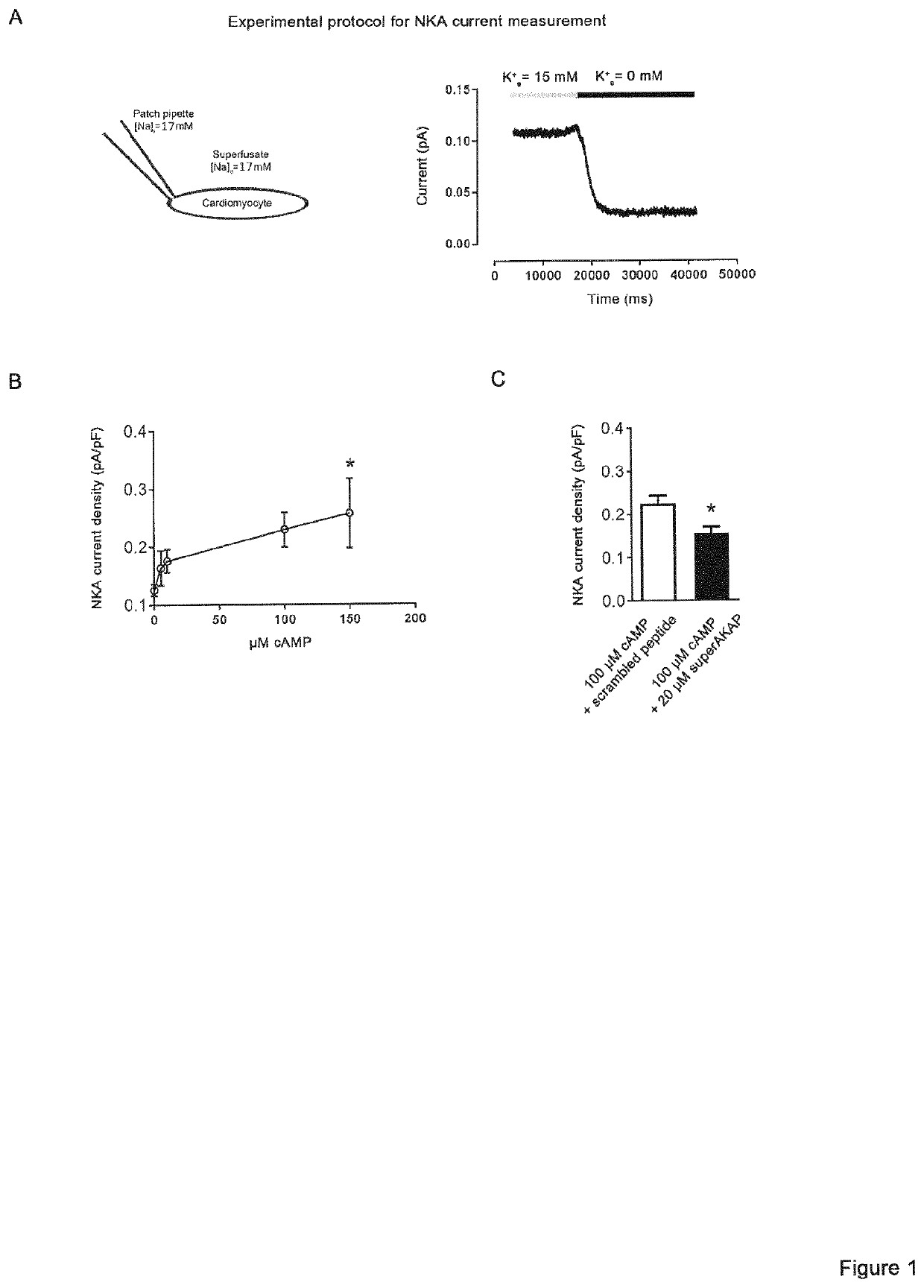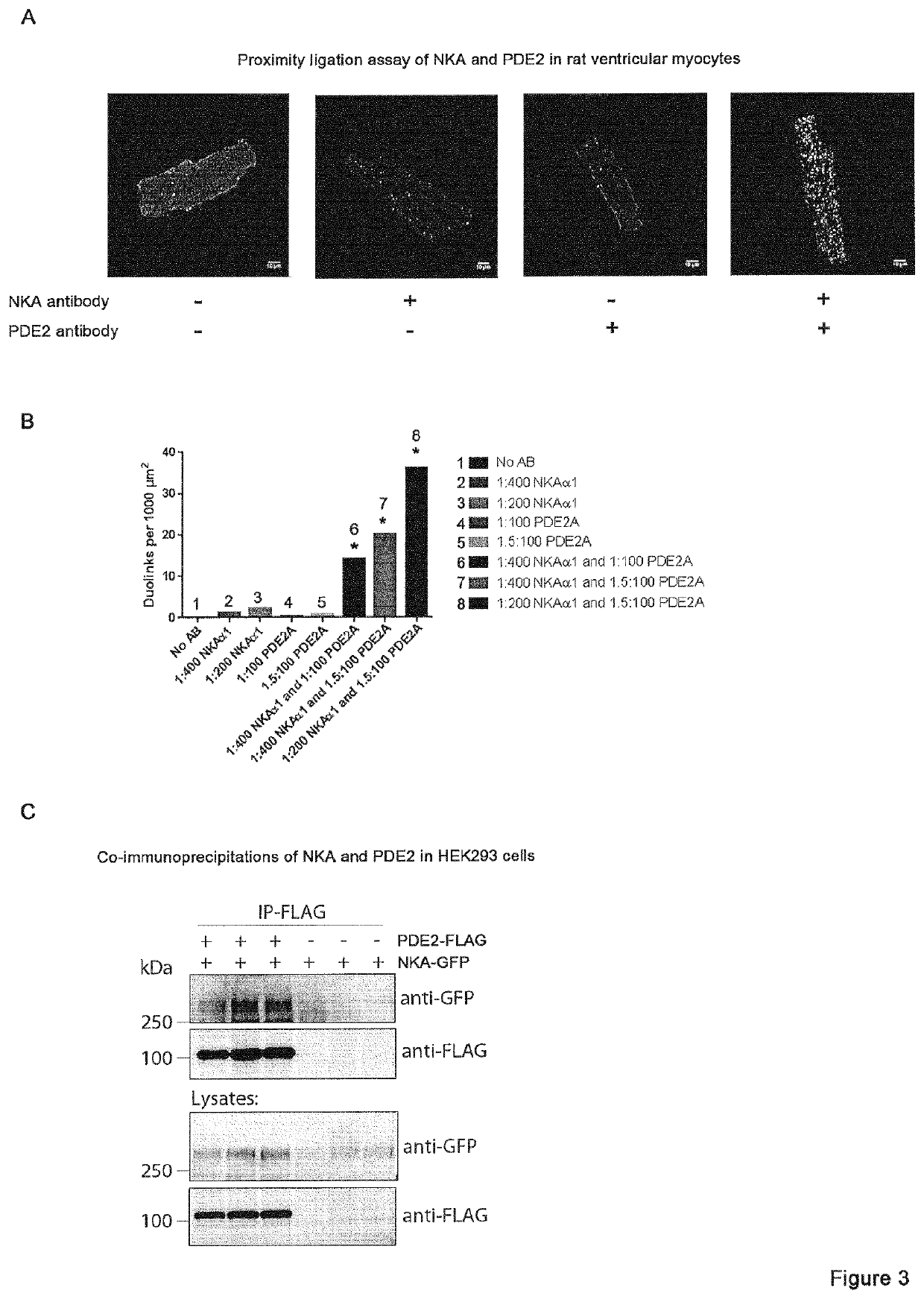Treatment of tachycardia
a tachyarrhythmia and treatment technology, applied in the field of phosphodiesterase 2, can solve the problems of cardiac arrest, patients with ventricular tachyarrhythmias, and agents often prove ineffective for patients
- Summary
- Abstract
- Description
- Claims
- Application Information
AI Technical Summary
Benefits of technology
Problems solved by technology
Method used
Image
Examples
example 1
[0091]The following methods were carried out to demonstrate that phosphodiesterase 2A inhibition activates the Na+ / K+-ATPase and prevents ventricular tachycardias.
[0092]Methods:
[0093]Animal Models
[0094]Animal experiments were performed in accordance with the Guide for the Care and Use of Laboratory Animals published by the US National Institutes of Health (NIH Publication No.85-23, revised 1996). Project approval was granted by the Norwegian National Animal Research Committee (FDU 2146, 7016 and 7040). Male Wistar rats with ˜300 g body weight (Møllegaard, Denmark) were stored two per cage in a temperature-regulated room on a 12:12 h day / night cycle and given access to food and water ad libitum. Mice were stored under similar conditions, and maximally six mice per cage were allowed. Aorta banding was performed in C57BL6 / J mice by a standardized constriction of the ascending aorta, and the mice were followed for 14-16 weeks. Development of congestive heart failure was verified by echo...
example 2
[0169]The methods of Example 1 were repeated with other known PDE2 inhibitors to demonstrate their activity in the prevention of ventricular tachycardias in mice.
[0170]In Vivo Recordings of Arrhythmias
[0171]ND-7001 (10 mg / kg) and LuAF64280 (20 mg / kg), were tested in HF mice 1 week after AB using the same experimental set-up as described in Example 1. DMSO was used for control injections. Marked cardiac remodeling was verified in all mice before injection of the PDE2 inhibitor and subsequent caffeine.
[0172]Results
[0173]PDE2 Inhibition Prevents Ventricular Tachycardia in Mice with Heart Failure
[0174]Both ND-7001 and LuAF64280 protected against VTs in HF mice: ND-7001 0 / 5 (0%) developed VT; LuAF64280 0 / 3 (0%) developed VT (FIG. 14). In total, four PDE2 inhibitors, Bay 60-7550, PF05180999, ND-7001, and LuAF64280, protected against VT in HF mice.
[0175]Conclusion
[0176]It has been shown that two further PDE2 inhibitors prevent ventricular tachycardia in established models.
example 3
[0177]The anti-arrhythmic effect of the PDE2 inhibitor Bay 60-7550 was tested against Metoprolol and in combination with Metoprolol, a commonly used anti-arrhythmic drug.
[0178]In Vivo Recordings of Arrhythmias
[0179]The anti-arrhythmic effect of the PDE2 inhibitor Bay 60-7550 was tested against Metoprolol in the same way as described in Example 1. We also included groups that received control injections and the combination of Bay 60-7550 and Metoprolol. Mice were randomly assigned to treatment groups, but with pre-determined group sizes. All groups were treated for five days; 5.5 mg / kg Metoprolol (see Zhou, Q., et al., Carvedilol and its new analogs suppress arrhythmogenic store overload-induced Ca2+ release. Nat. Med. 2011. 17(8): 1003-9) was injected once every day (in the morning), while 3 mg / kg Bay 60-7550 and control were injected twice every day (morning and evening). For chronic injections Bay 60-7550 was dissolved in 5% ethanol and 95% sunflower oil, and the control group rec...
PUM
| Property | Measurement | Unit |
|---|---|---|
| body weight | aaaaa | aaaaa |
| pH | aaaaa | aaaaa |
| series resistance | aaaaa | aaaaa |
Abstract
Description
Claims
Application Information
 Login to View More
Login to View More - R&D
- Intellectual Property
- Life Sciences
- Materials
- Tech Scout
- Unparalleled Data Quality
- Higher Quality Content
- 60% Fewer Hallucinations
Browse by: Latest US Patents, China's latest patents, Technical Efficacy Thesaurus, Application Domain, Technology Topic, Popular Technical Reports.
© 2025 PatSnap. All rights reserved.Legal|Privacy policy|Modern Slavery Act Transparency Statement|Sitemap|About US| Contact US: help@patsnap.com



